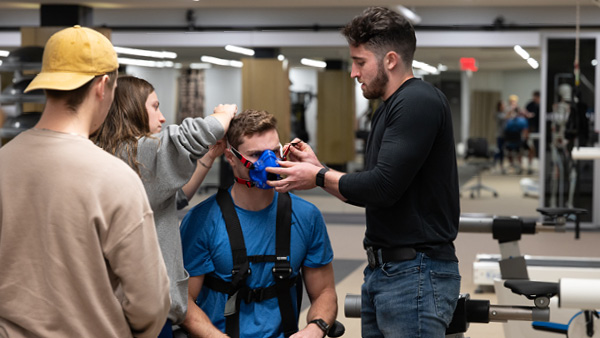There’s a quick yet purposeful rhythm to Steven Breitenfeld ’24’s stride when his feet strike the running belt of the treadmill in Bryant’s Exercise and Movement Science lab. As the Accounting senior steadily breathes into the blue face mask covering his mouth and nose, two thin tubes run from the mask to a metabolic cart on his left. He’s currently walking at a 1.7 mile per hour pace on a 10 percent incline.
“How hard are you working on a scale of six to twenty?” asks Alexis Cote ’27, an Exercise and Movement Science major who’s manning the metabolic cart and watching the machine capture his respiratory gases.
Breitenfeld tells her eight. Staring at the whiteboard straight ahead, his gaze settles on a drawing of a flower with “You got this” written underneath. Cote warns Breitenfeld of an impending pace change and ups the machine’s speed to 2.5 miles per hour with a 12 percent incline.
Breitenfeld increases his pace as his calves start feeling the slope.
Analyzing human movement
Studying how the body works and understanding the physiological changes that occur during exercise is the essence of Jason Sawyer Ph.D.’s “Exercise Physiology” course. Throughout the semester, students learn about heart rate and blood pressure baselines, how to keep bones healthy and increase their density, how to create a healthy sleep environment, and what happens to the body when individuals continually exercise.
“Students can then take the content that they've learned in the classroom and apply it in the exercise physiology lab,” says Sawyer, noting that the lab is optional.
In the lab, students work in groups — with one person calibrating a specific machine, another handling intake, and a third acting as a test subject. After the machine collects the test subject’s data, the group discusses the results and how that information can be used to inform health-related decisions.
One of the course’s highlights has been the use of the BOD POD, a sleek, egg-shaped device that provides a highly accurate measure of body composition. Individuals simply sit in the machine while air pressure technology works its magic.

“The software we have allows us to compare you to other populations,” says Sawyer, who serves as Exercise and Movement Science program director. “For instance, if you were a canoer, we could compare you to other canoers in the database. If you were a football player, we could break it down by position.”
“Exercise Physiology” is part of the School of Health and Behavioral Sciences’ Exercise and Movement Science program, which welcomed its first cohort of students to Bryant this past fall. The program offers two tracks: one in applied exercise and coaching and another in healthcare provider prep. Throughout students’ four years, they’ll gain knowledge in biomechanics, nutrition, research, exercise assessment and prescription, and programming.
“The class size is so small in the lab that we can all get to do something,” says Juliana Tierinni ’24, a Biology major on the pre-health track. “If this were a huge group, it would be way harder to be as hands-on as we are.”
Sawyer is mostly hands off in the lab, letting students learn by doing and using each other as resources. Even if there are hiccups along the way, like having to recalibrate the metabolic cart with a three-liter syringe, these moments play an integral part in the education process.
Breaking down results
Back on the treadmill, Breitenfeld signals that he’s done, and Cote stops the machine. Giving him a breather after his 13-minute workout, Sawyer’s students position their chairs in a semicircle so they can easily view the four new charts on the metabolic cart’s screen.
Pointing to the top left chart, Sawyer explains that it shows the volume of oxygen Breitenfeld consumed versus his time spent in a walk-run. He notes that the data also includes Breitenfeld’s recovery period and that individuals can manipulate the graph to focus solely on peak VO2.
For the next 15 minutes, they dissect the data — calling attention to the amount of air Breitenfeld moved through his body, analyzing heart rate over time, and comparing Breitenfeld’s results to other individuals in his gender and age bracket.
“We know that there is a decline in VO2 max as we age. Unfortunately, you really can't stop it, but you can decrease how quickly it goes down,” Sawyer tells students. “Put fitness in the bank now: It's like starting with a bigger bank account in retirement. If you have more money when you retire, you can spend more money in retirement.”
With class coming to a close, Sawyer hands Breitenfeld a printed copy of his VO2 data — a common practice within the course. While some students plan to use their results to inform exercise routines, others enjoy having the data so they know more about their bodies.
“Throughout the course, students are getting their exercise physiology content, but they're also getting the practical application,” Sawyer says. “Understanding how the body works and how it adapts during exercise can really benefit students throughout their entire life.”